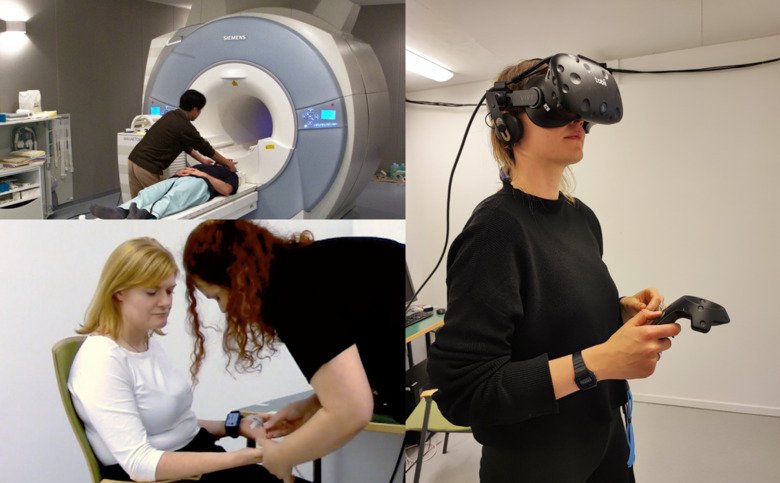 Photo: N/A
Photo: N/AForskning
Vårt övergripande mål är att bättre förstå hur emotionell information överförs, lärs in och regleras i sociala situationer.

The general aim of Emotion Lab's research is to describe behavioral, neural and computational principles underlying social and affective learning and decision-making.
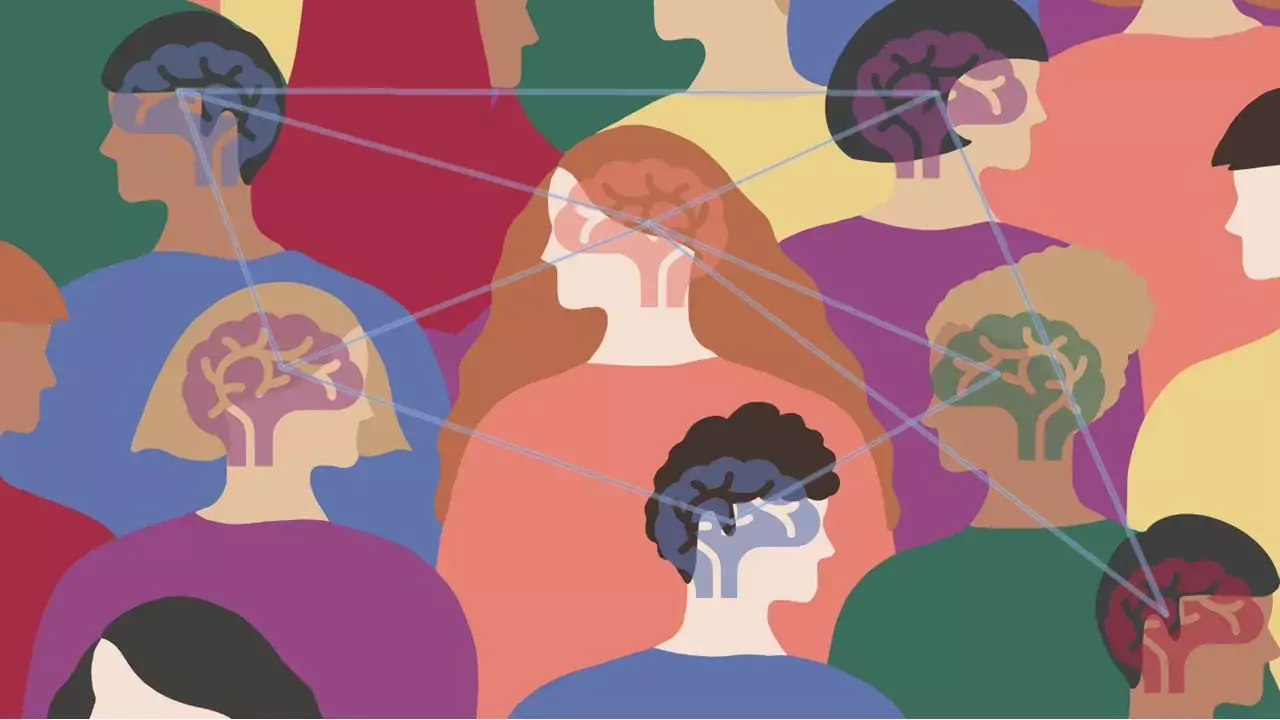
 Photo: N/A
Photo: N/AVårt övergripande mål är att bättre förstå hur emotionell information överförs, lärs in och regleras i sociala situationer.
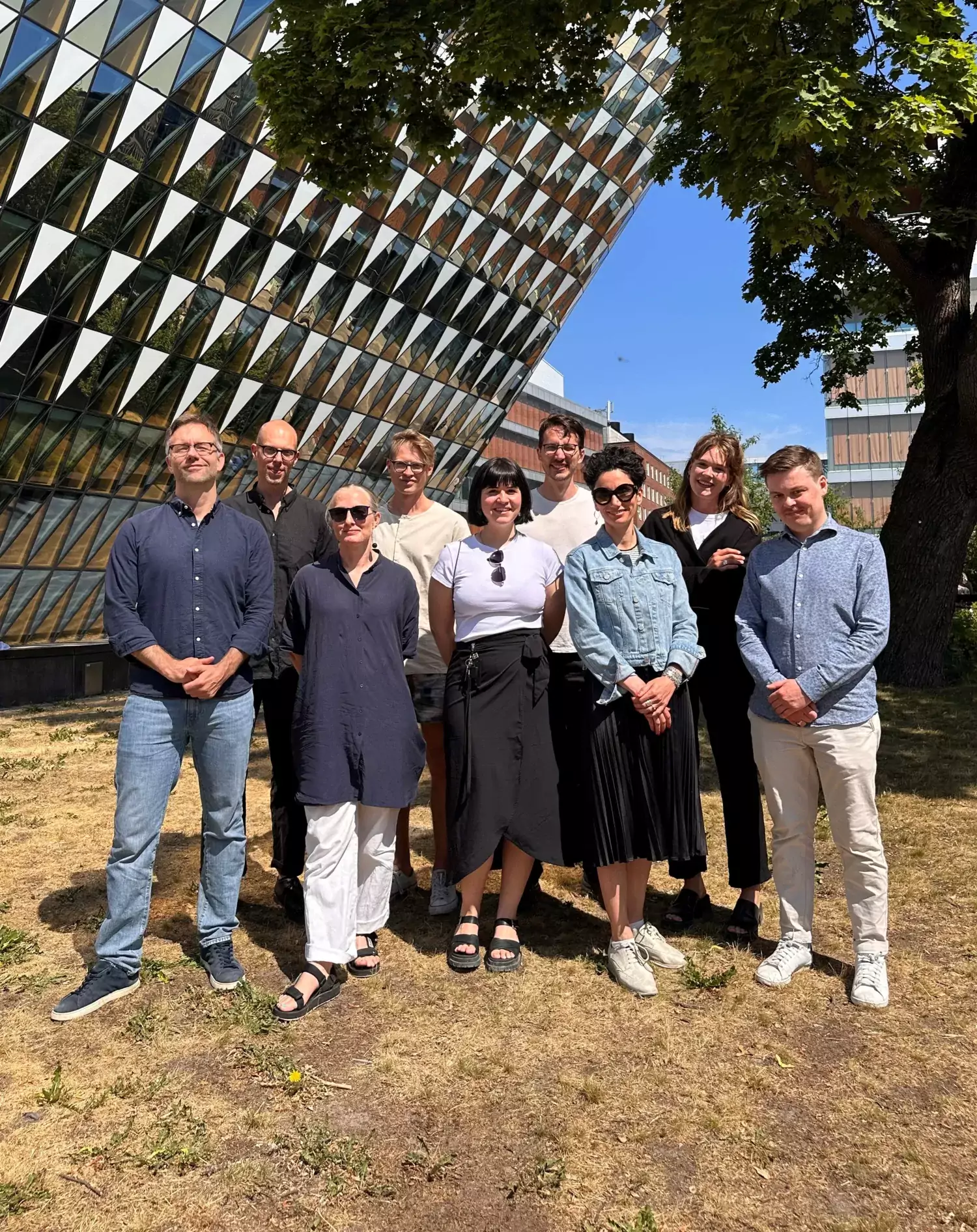 Photo: N/A
Photo: N/AEn lista över våra nuvarande och tidigare medlemmar.
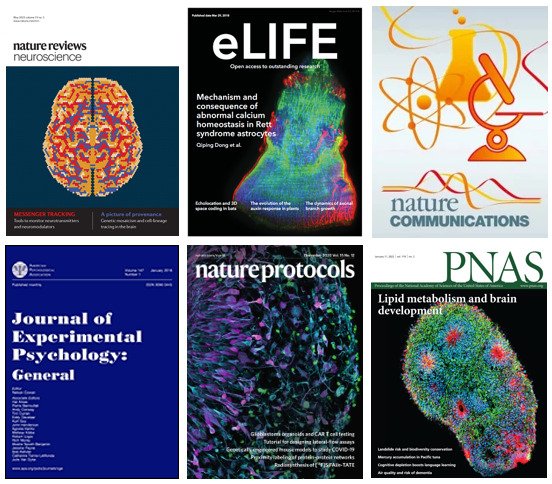 Photo: N/A
Photo: N/AKommande och publicerade vetenskapliga artiklar och bokkapitel.
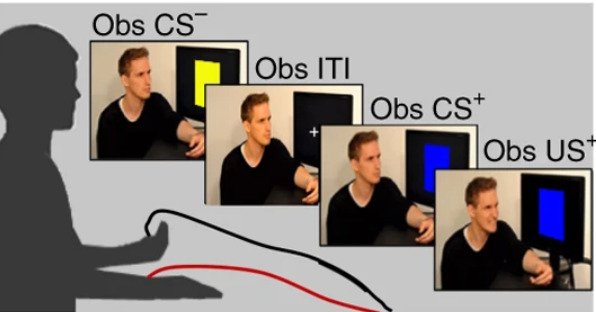 Photo: N/A
Photo: N/AHär kan du hitta användbara paradigm och material.
Det övergripande målet med Emotion Labs forskning är att beskriva de beteendemässiga, neurala och beräkningsmässiga principer som ligger till grund för social och affektiv inlärning och beslutsfattande.
Selbing, I., Becker, N., Pan, Y., Lindström, B., & Olsson, A. (2025). Effects of described demonstrator ability on brain and behavior when learning from others. npj Sci. Learn. 10, 4. https://www.nature.com/articles/s41539-024-00292-0
Jangard, S., Olsson, A., Jayaram-Lindströma, N., Raninena, J. (2025). Antisocial and Prosocial Behaviors as Predictors of Subsequent Substance Use in Adolescence, Addictive Behaviors, accepted. https://sciety.org/articles/activity/10.31234/osf.io/59483_v1
Jangard, S., Lindström, B., Khemiri, L., Jayaram, N., Olsson, A. (2025). Dissociating social reward learning and behavior in alcohol use disorder. Translational Psychiatry, 15, 30. https://www.nature.com/articles/s41398-025-03236-3
Espinosa, L., Nook, E., Asperholm, M., Collins T., Davidow J., Olsson, A. (2024). Peer threat evaluations shape one’s own threat perceptions and feelings of distress, Cognition & Emotion, 1–14. https://pubmed.ncbi.nlm.nih.gov/39530614/
Acar K., Karagiannidou A., Olsson A., van Prooijen J.W., Balter L.J.T., Axelsson J., Ingvar M., Lebedev A.V., Petrovic P. (2024). Delusion-proneness predicts COVID-19 vaccination behavior. Frontiers in Psychiatry, Nov 25;15:1450429. https://www.frontiersin.org/journals/psychiatry/articles/10.3389/fpsyt.2024.1450429/full
Pan, Y., Sequestro, M., Golkar, A., Olsson, A. (2024). Handholding reduces the recovery of threat memories and magnifies prefrontal hemodynamic responses, Behav Res Ther, Dec;183:104641. https://pubmed.ncbi.nlm.nih.gov/39366088/
Čehajić-Clancy, S., Jamshed, N., Olsson, A., & Momčilović, A. (2024). From inspiration to restoration: Moral elevation as a catalyst for improving intergroup relations in contexts of conflict. Journal of Personality and Social Psychology, in press. https://pubmed.ncbi.nlm.nih.gov/39172431/
Vieira, B., J., & Olsson, A. (2024). The convergence between defence and care-based helping in mammals, Trends in Cognitive Sciences, TICS, 28(8):714-725. https://www.sciencedirect.com/science/article/pii/S1364661324001062
Selbing, I., Sandberg, D., Olsson, A., Lindström, B., & Golkar, A. (2024). The Transfer of Social Threat Learning to Decision-Making is Robust to Extinction, Emotion, Oct;24(7):1689-1696. https://psycnet.apa.org/fulltext/2024-95971-001.html
Becker, N., Kühn, S., & Olsson, A. (2024). How Emotional Contexts Modulate Item Memory in Individuals with High and Low Negative Affect and Worry, Learning & Memory, May 13;31(4):a053891. https://pubmed.ncbi.nlm.nih.gov/38740426/
Anxiety associated with perceived uncontrollable stress enhances expectations of environmental volatility and impairs reward learning.
Guitart-Masip M, Walsh A, Dayan P, Olsson A
Sci Rep 2023 Oct;13(1):18451
Neuroimaging and behavioral evidence that violent video games exert no negative effect on human empathy for pain and emotional reactivity to violence.
Lengersdorff LL, Wagner IC, Mittmann G, Sastre-Yagüe D, Lüttig A, Olsson A, Petrovic P, Lamm C
Elife 2023 Nov;12():
A Brain-To-Brain Mechanism for Social Transmission of Threat Learning.
Pan Y, Vinding MC, Zhang L, Lundqvist D, Olsson A
Adv Sci (Weinh) 2023 Aug;():e2304037
Reading Others’ Social Appraisals After Viewing an Aversive Film Online Impacts Mood But Not Intrusive Memories. Espinosa L, Singh L, Eimer T, Olsson A, Holmes EA. J Anxiety Disord 2023 Aug
Psychophysiological and computational correlates of enhanced Pavlovian threat conditioning to positive and negative emotional stimuli. Stussi Y, Pourtois G, Olsson,A, Sander D. Int J Psychophysiol 2023 June
Forthcoming: Grand Theft Empathy? Evidence for the absence of effects of violent video games on empathy for pain and emotional reactivity to violence. Lengersdorff L, Wagner I, Olsson A, Petrovic P, Lamm C. Elife.
Threaten and affirm: The role of ingroup moral exemplars for promoting prosocial intergroup behavior through affirming moral identity. Cehajic-Clancy S, Olsson, A. Group Processes and Intergroup Relations.
Social and moral psychology of COVID-19 across 69 countries.
Azevedo F, ... Olsson A, ... Jangard S, ... Pärnamets P, ... Vieira JB, ... et al.
Sci Data 2023 May;10(1):272
Consensus design of a calibration experiment for human fear conditioning.
Bach DR, Sporrer J, Abend R, Beckers T, Dunsmoor JE, Fullana MA, Gamer M, Gee DG, Hamm A, Hartley CA, Herringa RJ, Jovanovic T, Kalisch R, Knight DC, Lissek S, Lonsdorf TB, Merz CJ, Milad M, Morriss J, Phelps EA, Pine DS, Olsson A, van Reekum CM, Schiller D
Neurosci Biobehav Rev 2023 May;148():105146
The causal role of affect sharing in driving vicarious fear learning.
Müllner-Huber A, Anton-Boicuk L, Pronizius E, Lengersdorff L, Olsson A, Lamm C
PLoS One 2022 ;17(11):e0277793
Neural defensive circuits underlie helping under threat in humans.
Vieira JB, Olsson A
Elife 2022 Oct;11():
Pavlovian threat conditioning can generate intrusive memories that persist over time.
Espinosa L, Bonsall MB, Becker N, Holmes EA, Olsson A
Behav Res Ther 2022 Oct;157():104161
Predicting attitudinal and behavioral responses to COVID-19 pandemic using machine learning.
Pavlović T, Azevedo F, ... Olsson A, ..., Keudel O, ...
PNAS Nexus 2022 Jul;1(3):pgac093
COVID-19 conspiracy ideation is associated with the delusion proneness trait and resistance to update of beliefs.
Acar K, Horntvedt O, Cabrera A, Olsson A, Ingvar M, Lebedev AV, Petrovic P
Sci Rep 2022 Jun;12(1):10352
Psychological well-being is associated with prosociality during the COVID-19 pandemic: A comparison of Swedish and Chinese samples.
Pan Y, Vieira JB, Pärnamets P, Jangard S, Cheng X, Zhang Y, Olsson A
Emotion 2022 Aug;():
Alcohol Use Disorder Displays Trait-Related Reductions in Prosocial Decision Making.
Jangard S, Lindström B, Khemiri L, Pärnamets P, Jayaram-Lindström N, Olsson A
Biol Psychiatry Cogn Neurosci Neuroimaging 2022 Sep;7(9):925-934
Enhanced Instructed Fear Learning in Delusion-Proneness.
Louzolo A, Almeida R, Guitart-Masip M, Björnsdotter M, Lebedev A, Ingvar M, Olsson A, Petrovic P
Front Psychol 2022 ;13():786778
Does gender matter? The association between different digital media activities and adolescent well-being.
Svensson R, Johnson B, Olsson A
BMC Public Health 2022 Feb;22(1):273
National identity predicts public health support during a global pandemic.
Van Bavel JJ, Cichocka A, Capraro V, Sjåstad H, Nezlek JB, Pavlović T, Alfano M, ..., Olsson A, ..., Jangard S, ..., Pärnamets P, ..., Vieira JB, ...
Nat Commun 2022 Jan;13(1):517
Resistance to Extinction of Evaluative Fear Conditioning in Delusion Proneness
Louzolo A, Lebedev A, Björnsdotter M, Acar K, Ahrends C, Kringelbach M L, Ingvar M, Olsson A, Petrovic P
Schizophr Bull Open 2022 ;3(1):sgac033
Model-based representational similarity analysis of blood-oxygen-level-dependent fMRI captures threat learning in social interactions.
Undeger I, Visser RM, Becker N, de Boer L, Golkar A, Olsson A
R Soc Open Sci 2021 Nov;8(11):202116
The Interpersonal Neuroscience of Social Learning.
Pan Y, Novembre G, Olsson A
Perspect Psychol Sci 2022 May;17(3):680-695
Observation of others' threat reactions recovers memories previously shaped by firsthand experiences.
Haaker J, Diaz-Mataix L, Guillazo-Blanch G, Stark SA, Kern L, LeDoux JE, Olsson A
Proc Natl Acad Sci U S A 2021 Jul;118(30):
Psychedelic drug use and schizotypy in young adults.
Lebedev AV, Acar K, Garzón B, Almeida R, Råback J, Åberg A, Martinsson S, Olsson A, Louzolo A, Pärnamets P, Lövden M, Atlas L, Ingvar M, Petrovic P
Sci Rep 2021 Jul;11(1):15058
The face value of feedback: facial behaviour is shaped by goals and punishments during interaction with dynamic faces.
Yi J, Pärnamets P, Olsson A
R Soc Open Sci 2021 Jul;8(7):202159
Social safety learning: Shared safety abolishes the recovery of learned threat.
Pan Y, Olsson A, Golkar A
Behav Res Ther 2020 Dec;135():103733
Observational learning of fear in real time procedure.
Szczepanik M, Kaźmierowska AM, Michałowski JM, Wypych M, Olsson A, Knapska E
Sci Rep 2020 Oct;10(1):16960
Enhanced social learning of threat in adults with autism.
Espinosa L, Lundin Kleberg J, Hofvander B, Berggren S, Bölte S, Olsson A
Mol Autism 2020 Sep;11(1):71
Integration of social cues and individual experiences during instrumental avoidance learning.
Pärnamets P, Olsson A
PLoS Comput Biol 2020 Sep;16(9):e1008163
Help or flight? Increased threat imminence promotes defensive helping in humans.
Vieira JB, Schellhaas S, Enström E, Olsson A
Proc Biol Sci 2020 Aug;287(1933):20201473
Neural Pattern Similarity Unveils the Integration of Social Information and Aversive Learning.
Undeger I, Visser RM, Olsson A
Cereb Cortex 2020 Sep;30(10):5410-5419
Acute anxiety during the COVID-19 pandemic was associated with higher levels of everyday altruism.
Vieira JB, Pierzchajlo S, Jangard S, Marsh AA, Olsson A
Sci Rep 2022 Nov;12(1):18619
Physiological synchrony predicts observational threat learning in humans.
Pärnamets P, Espinosa L, Olsson A
Proc Biol Sci 2020 May;287(1927):20192779
Intact Classical Fear Conditioning to Interpersonally Threatening Stimuli in Borderline Personality Disorder.
Hillmann K, Mancke F, Herpertz SC, Jungkunz M, Olsson A, Haaker J, Bertsch K
Psychopathology 2020 ;53(2):84-94
The neural and computational systems of social learning.
Olsson A, Knapska E, Lindström B
Nat Rev Neurosci 2020 Apr;21(4):197-212
Book chapter: N Lanbeck, D Garcia, C Amato, A Olsson, S Sikström. Implicit attitudes: Quantitative semantic misattribution procedure. In: Sikström & Garcia (Eds.), Statistical Semantics: Methods and Applications, Springer, 2020
Learning biases to angry and happy faces during Pavlovian aversive conditioning.
Stussi Y, Pourtois G, Olsson A, Sander D
Emotion 2021 Jun;21(4):742-756
Anxious behaviour in a demonstrator affects observational learning.
Selbing I, Olsson A
Sci Rep 2019 Jun;9(1):9181
Social threat learning transfers to decision making in humans.
Lindström B, Golkar A, Jangard S, Tobler PN, Olsson A
Proc Natl Acad Sci U S A 2019 Mar;116(10):4732-4737
Social regulation of survival circuits through learning. Olsson A, FeldmanHall O, Haaker J, Hensler T. Current Opinion in Behavioral Sciences 2018 Dec; 24:161-167
Conference: Building and Dismantling Trust: From Group Learning to Character Judgments. Pärnamets P, Granwald T, Olsson A. Proceedings of the 40th Annual Conference of the Cognitive Science Society, Cognitive Science Society, Austin, TX, 2018
Book chapter: Olsson A, Spring V. The vicarious brain: Integrating empathy and emotional learning. In: Meyza & Knapska (Eds.), Neuronal correlates of empathy: From rodent to human, Academic Press, 2018, ISBN: 9780128093481.
A common neural network differentially mediates direct and social fear learning.
Lindström B, Haaker J, Olsson A
Neuroimage 2018 Feb;167():121-129
The role of a "common is moral" heuristic in the stability and change of moral norms.
Lindström B, Jangard S, Selbing I, Olsson A
J Exp Psychol Gen 2018 Feb;147(2):228-242
Beliefs about Others' Abilities Alter Learning from Observation.
Selbing I, Olsson A
Sci Rep 2017 Nov;7(1):16173
PhD Thesis: Selbing I. Learning from the behaviors and experiences of others.
The interplay of social group biases in social threat learning.
Golkar A, Olsson A
Sci Rep 2017 Aug;7(1):7685
Social Fear Learning: from Animal Models to Human Function.
Debiec J, Olsson A
Trends Cogn Sci 2017 Jul;21(7):546-555
Assessment of social transmission of threats in humans using observational fear conditioning.
Haaker J, Golkar A, Selbing I, Olsson A
Nat Protoc 2017 Jul;12(7):1378-1386
Endogenous opioids regulate social threat learning in humans.
Haaker J, Yi J, Petrovic P, Olsson A
Nat Commun 2017 May;8():15495
Delusion-proneness displays comorbidity with traits of autistic-spectrum disorders and ADHD.
Louzolo A, Gustavsson P, Tigerström L, Ingvar M, Olsson A, Petrovic P
PLoS One 2017 ;12(5):e0177820
Book chapter: Olsson A, Undeger I. Evolved physiological reactions. In: Shackelford & Weekes-Shackelford, (Eds.), Encyclopedia of Evolutionary Psychological Science, Springer, Cham, 2017
Effects of 25 mg oxazepam on emotional mimicry and empathy for pain: a randomized controlled experiment.
Nilsonne G, Tamm S, Golkar A, Sörman K, Howner K, Kristiansson M, Olsson A, Ingvar M, Petrovic P
R Soc Open Sci 2017 Mar;4(3):160607
PhD Thesis: Molapour T. The role of aversive learning in social interactions.
Conditioned social dominance threat: observation of others' social dominance biases threat learning.
Haaker J, Molapour T, Olsson A
Soc Cogn Affect Neurosci 2016 Oct;11(10):1627-37
Outline of a sensory-motor perspective on intrinsically moral agents. Balkenius C, Cañamero L, Pärnamets P, Johansson B, Butz MV, Olsson A. Adaptive Behavior. 2016 Oct;24(5):306-319.
Co-Evolution of Social Learning and Evolutionary Preparedness in Dangerous Environments.
Lindström B, Selbing I, Olsson A
PLoS One 2016 ;11(8):e0160245
Significant grey matter changes in a region of the orbitofrontal cortex in healthy participants predicts emotional dysregulation.
Petrovic P, Ekman CJ, Klahr J, Tigerström L, Rydén G, Johansson AG, Sellgren C, Golkar A, Olsson A, Öhman A, Ingvar M, Landén M
Soc Cogn Affect Neurosci 2016 Jul;11(7):1041-9
Aversive Learning and Trait Aggression Influence Retaliatory Behavior.
Molapour T, Lindström B, Olsson A
Front Psychol 2016 ;7():833
Neural signals of vicarious extinction learning.
Golkar A, Haaker J, Selbing I, Olsson A
Soc Cogn Affect Neurosci 2016 Oct;11(10):1541-9
Immunization against social fear learning.
Golkar A, Olsson A
J Exp Psychol Gen 2016 Jun;145(6):665-71
Vicarious Fear Learning Depends on Empathic Appraisals and Trait Empathy.
Olsson A, McMahon K, Papenberg G, Zaki J, Bolger N, Ochsner KN
Psychol Sci 2016 Jan;27(1):25-33
Testosterone and estrogen impact social evaluations and vicarious emotions: A double-blind placebo-controlled study.
Olsson A, Kopsida E, Sorjonen K, Savic I
Emotion 2016 Jun;16(4):515-23
Book chapter: Olsson A, Undeger I, Yi J. Emotional learning and regulation in social situations. In: Absher & Cloutier, (Eds.), Neuroimaging Personality, Social Cognition, and Character, Academic Press, 2016
Neural correlates of biased social fear learning and interaction in an intergroup context.
Molapour T, Golkar A, Navarrete CD, Haaker J, Olsson A
Neuroimage 2015 Nov;121():171-83
A clash of values: Fear-relevant stimuli can enhance or corrupt adaptive behavior through competition between Pavlovian and instrumental valuation systems.
Lindström B, Golkar A, Olsson A
Emotion 2015 Oct;15(5):668-76
Mechanisms of social avoidance learning can explain the emergence of adaptive and arbitrary behavioral traditions in humans.
Lindström B, Olsson A
J Exp Psychol Gen 2015 Jun;144(3):688-703
Neural and genetic markers of vulnerability to post-traumatic stress symptoms among survivors of the World Trade Center attacks.
Olsson A, Kross E, Nordberg SS, Weinberg A, Weber J, Schmer-Galunder S, Fossella J, Wager TD, Bonanno GA, Ochsner KN
Soc Cogn Affect Neurosci 2015 Jun;10(6):863-8
BDNFval66met affects neural activation pattern during fear conditioning and 24 h delayed fear recall.
Lonsdorf TB, Golkar A, Lindström KM, Haaker J, Öhman A, Schalling M, Ingvar M
Soc Cogn Affect Neurosci 2015 May;10(5):664-71
Spontaneous eye movements and trait empathy predict vicarious learning of fear.
Kleberg JL, Selbing I, Lundqvist D, Hofvander B, Olsson A
Int J Psychophysiol 2015 Dec;98(3 Pt 2):577-83
Learned fear to social out-group members are determined by ethnicity and prior exposure.
Golkar A, Björnstjerna M, Olsson A
Front Psychol 2015 ;6():123
Social learning of fear and safety is determined by the demonstrator's racial group.
Golkar A, Castro V, Olsson A
Biol Lett 2015 Jan;11(1):20140817
A ten-year follow-up of a study of memory for the attack of September 11, 2001: Flashbulb memories and memories for flashbulb events.
Hirst W, Phelps EA, Meksin R, Vaidya CJ, Johnson MK, Mitchell KJ, Buckner RL, Budson AE, Gabrieli JD, Lustig C, Mather M, Ochsner KN, Schacter D, Simons JS, Lyle KB, Cuc AF, Olsson A
J Exp Psychol Gen 2015 Jun;144(3):604-23
The Hidden Snake in the Grass: Superior Detection of Snakes in Challenging Attentional Conditions.
Soares SC, Lindström B, Esteves F, Ohman A
PLoS One 2014 ;9(12):e114724
Demonstrator skill modulates observational aversive learning.
Selbing I, Lindström B, Olsson A
Cognition 2014 Oct;133(1):128-39
The influence of work-related chronic stress on the regulation of emotion and on functional connectivity in the brain.
Golkar A, Johansson E, Kasahara M, Osika W, Perski A, Savic I
PLoS One 2014 ;9(9):e104550
A review on human reinstatement studies: an overview and methodological challenges.
Haaker J, Golkar A, Hermans D, Lonsdorf TB
Learn Mem 2014 Sep;21(9):424-40
PhD Thesis: Lindström B. Socially dependent avoidance learning: Mechanisms of adaptive behavior.
Racial bias shapes social reinforcement learning.
Lindström B, Selbing I, Molapour T, Olsson A
Psychol Sci 2014 Mar;25(3):711-9
Other people as means to a safe end: vicarious extinction blocks the return of learned fear.
Golkar A, Selbing I, Flygare O, Ohman A, Olsson A
Psychol Sci 2013 Nov;24(11):2182-90
Cues of fatigue: effects of sleep deprivation on facial appearance.
Sundelin T, Lekander M, Kecklund G, Van Someren EJ, Olsson A, Axelsson J
Sleep 2013 Sep;36(9):1355-60
In Your Face: Risk of Punishment Enhances Cognitive Control and Error-Related Activity in the Corrugator Supercilii Muscle.
Lindström BR, Mattsson-Mårn IB, Golkar A, Olsson A
PLoS One 2013 ;8(6):e65692
Learning biases underlying individual differences in sensitivity to social rejection.
Olsson A, Carmona S, Downey G, Bolger N, Ochsner KN
Emotion 2013 Aug;13(4):616-21
Temporal properties of fear extinction--does time matter?
Golkar A, Bellander M, Öhman A
Behav Neurosci 2013 Feb;127(1):59-69
Book chapter: Olsson A. Empati ur ett neurovetenskapligt perspektiv [Empathy from a neuroscientific perspective]. In: Bohlin & Ekelund, (Ed.s), Empati, Studentlitteratur, 2013
Distinct contributions of the dorsolateral prefrontal and orbitofrontal cortex during emotion regulation.
Golkar A, Lonsdorf TB, Olsson A, Lindstrom KM, Berrebi J, Fransson P, Schalling M, Ingvar M, Öhman A
PLoS One 2012 ;7(11):e48107
Fear extinction in humans: effects of acquisition-extinction delay and masked stimulus presentations.
Golkar A, Öhman A
Biol Psychol 2012 Oct;91(2):292-301
Fear is readily associated with an out-group face in a minimal group context. Navarrete CD, McDonald MM, Asher BD, Kerr NL, Yokota K, Olsson A, Sidanius J. Evolution and Human Behavior, 2012 Sep; 33(5); 590–593
Evolutionary derived modulations of attention to two common fear stimuli: Serpents and hostile humans. Öhman A, Soares SC, Juth P, Lindström B, Esteves F. Journal of Cognitive Psychology, 2012 Jan; 24 (1): 17–32
Emotional responses in spider fear are closely related to picture awareness.
Peira N, Golkar A, Ohman A, Anders S, Wiens S
Cogn Emot 2012 ;26(2):252-60
Are fear memories erasable?-reconsolidation of learned fear with fear-relevant and fear-irrelevant stimuli.
Golkar A, Bellander M, Olsson A, Ohman A
Front Behav Neurosci 2012 ;6():80
Threat-relevance impairs executive functions: negative impact on working memory and response inhibition.
Lindström BR, Bohlin G
Emotion 2012 Apr;12(2):384-93
Emotion processing facilitates working memory performance.
Lindström BR, Bohlin G
Cogn Emot 2011 Nov;25(7):1196-204
Book chapter: Olsson A. The impact of social cognition on emotional learning from and about others: A neurobiological perspective. In: Schachtman & Reilly, (Eds.), Associative Learning and Conditioning Theory: Human and Non-Human Applications, Oxford University Press, 2011
5-HTTLPR and COMTval158met genotype gate amygdala reactivity and habituation.
Lonsdorf TB, Golkar A, Lindstöm KM, Fransson P, Schalling M, Ohman A, Ingvar M
Biol Psychol 2011 Apr;87(1):106-12
Beauty sleep: experimental study on the perceived health and attractiveness of sleep deprived people.
Axelsson J, Sundelin T, Ingre M, Van Someren EJ, Olsson A, Lekander M
BMJ 2010 Dec;341():c6614
Finding the face in a crowd: Relationships between distractor redundancy, target emotion, and target gender. Öhman A, Juth P, Lundqvist D. Cognition & Emotion, 2010 Oct; 24(7),1216–1228
Social problem solving, autobiographical memory, trauma, and depression in women with borderline personality disorder and a history of suicide attempts.
Maurex L, Lekander M, Nilsonne A, Andersson EE, Asberg M, Ohman A
Br J Clin Psychol 2010 Sep;49(Pt 3):327-42
Amygdala-dependent fear conditioning in humans is modulated by the BDNFval66met polymorphism.
Lonsdorf TB, Weike AI, Golkar A, Schalling M, Hamm AO, Öhman A
Behav Neurosci 2010 Feb;124(1):9-15
The serotonin transporter gene polymorphism (5-HTTLPR) and affective symptoms among women diagnosed with borderline personality disorder.
Maurex L, Zaboli G, Ohman A, Asberg M, Leopardi R
Eur Psychiatry 2010 Jan;25(1):19-25
Incollection: Olsson A. Observational fear learning. In: Seel, (Ed.), Encyclopedia of the Science of Learning, Springer US, 2010
What you fear will appear: detection of schematic spiders in spider fear.
Peira N, Golkar A, Larsson M, Wiens S
Exp Psychol 2010 ;57(6):470-5
Of snakes and faces: an evolutionary perspective on the psychology of fear.
Ohman A
Scand J Psychol 2009 Dec;50(6):543-52
Distinct control networks for cognition and emotion in the prefrontal cortex.
Kompus K, Hugdahl K, Ohman A, Marklund P, Nyberg L
Neurosci Lett 2009 Dec;467(2):76-80
Some animal specific fears are more specific than others: Evidence from attention and emotion measures.
Soares SC, Esteves F, Lundqvist D, Ohman A
Behav Res Ther 2009 Dec;47(12):1032-42
The symptomatic profile of panic disorder is shaped by the 5-HTTLPR polymorphism.
Lonsdorf TB, Rück C, Bergström J, Andersson G, Ohman A, Schalling M, Lindefors N
Prog Neuropsychopharmacol Biol Psychiatry 2009 Nov;33(8):1479-83
Book chapter: Olsson A, Öhman A. The affective neuroscience of emotion: Automatic activation, interoception, and emotion regulation. In: Berntson & Cacioppo, (Eds.), Handbook of Neuroscience for the Behavioral Sciences, 2 , John Wiley & Sons, 2009
Is cultivating “biological blindness” a viable route to understanding behavioral phenomena?. Olsson A, Öhman A. Behavioral and Brain Sciences, 2009 Apr;32(2): 220
Genetic gating of human fear learning and extinction: possible implications for gene-environment interaction in anxiety disorder.
Lonsdorf TB, Weike AI, Nikamo P, Schalling M, Hamm AO, Ohman A
Psychol Sci 2009 Feb;20(2):198-206
Fear extinction to an out-group face: the role of target gender.
Navarrete CD, Olsson A, Ho AK, Mendes WB, Thomsen L, Sidanius J
Psychol Sci 2009 Feb;20(2):155-8
Emotionally controlled decision-making and a gene variant related to serotonin synthesis in women with borderline personality disorder.
Maurex L, Zaboli G, Wiens S, Asberg M, Leopardi R, Ohman A
Scand J Psychol 2009 Feb;50(1):5-10
Book chapter: Öhman A. Fear. In: Sander & Scherer, (Eds.), Oxford Companion to Emotion and the Affective Sciences, Oxford University Press, 2009
Book chapter: Öhman A. Phobia and Human Evolution. In: Squire, (Ed.), Encyclopedia of Neuroscience, Academic Press, 2009
Book chapter: Öhman A. Human fear conditioning and the amygdala. In: Whalen & Phelps, (Eds.), The Human Amygdala, The Guilford Press, 2009
Book chapter: Öhman A. Post-traumatic fear memories: Analysing a case study of a sexual assault. In: Bäckman & Nyberg (Eds.), Memory, aging and the brain: A Festschrift in honour of Lars-Göran Nilsson, Psychology Press, 2009
The role of social cognition in emotion.
Olsson A, Ochsner KN
Trends Cogn Sci 2008 Feb;12(2):65-71
Book chapter: Öhman A. Fear and anxiety: Overlaps and dissociations. In: Lewis, Haviland-Jones & Barrett, (Eds.), Handbook of Emotions, Guilford, 2008
Recognizing masked threat: fear betrays, but disgust you can trust.
Wiens S, Peira N, Golkar A, Ohman A
Emotion 2008 Dec;8(6):810-9
Has evolution primed humans to "beware the beast"?
Ohman A
Proc Natl Acad Sci U S A 2007 Oct;104(42):16396-7
On the unconscious subcortical origin of human fear.
Ohman A, Carlsson K, Lundqvist D, Ingvar M
Physiol Behav 2007 Sep;92(1-2):180-5
Social learning of fear.
Olsson A, Phelps EA
Nat Neurosci 2007 Sep;10(9):1095-102
Book chapter: Öhman A, Olsson A. Emotioner [Emotions]. In Olson, (Ed.), Hjärnan, Karolinska Institutet University Press, 2007
Book chapter: Öhman A. Anxiety. In: Fink, (Ed.), Encyclopedia of Stress, Elsevier, 2007
Book chapter: Öhman A. Fear. In: Fink, (Ed.), Encyclopedia of Stress, Elsevier, 2007
Book chapter: Wiens S, Öhman A. Probing unconscious emotional processes: On becoming a successful masketeer. In: Coan & Allen, (Eds.), Handbook of emotion elicitation and assessment, Oxford University Press, 2007
Learning fears by observing others: the neural systems of social fear transmission.
Olsson A, Nearing KI, Phelps EA
Soc Cogn Affect Neurosci 2007 Mar;2(1):3-11
Skin conductance responses to masked conditioned stimuli: phylogenetic/ontogenetic factors versus direction of threat?
Flykt A, Esteves F, Ohman A
Biol Psychol 2007 Mar;74(3):328-36
Book chapter: Olsson A, Phelps EA. Understanding social evaluations: What we can (and cannot) learn from neuroimaging. In: Wittenbrink & Schwarz, (Eds.), Implicit measures of attitudes: Procedures and controversies, Guilford Press, 2007
Book chapter: Öhman A., Rück C. Four Principles of Fear and Their Implications for Phobias. In: Rottenberg & Johnson, (Eds.), Emotion and psychopathology: Bridging affective and clinical science, American Psychological Association
Predictability modulates the affective and sensory-discriminative neural processing of pain.
Carlsson K, Andersson J, Petrovic P, Petersson KM, Ohman A, Ingvar M
Neuroimage 2006 Oct;32(4):1804-14
Essay: Öhman A. Making sense of emotion: evolution, reason & the brain, Daedalus 2006 Jul;135(3):33–45
Extending animal models of fear conditioning to humans.
Delgado MR, Olsson A, Phelps EA
Biol Psychol 2006 Jul;73(1):39-48
Book chapter: Öhman A. Automatic processes in emotion: Capture of attention and emotion activation. In: Jing & Rosenzweig, (Eds.), Progress in Psychological Science Around the World: Volume 1 Neural, Cognitive and Developmental Issues: Proceedings of the 28th International Congress of Psychology, Psychology Press, 2006
Failure to detect mismatches between intention and outcome in a simple decision task.
Johansson P, Hall L, Sikström S, Olsson A
Science 2005 Oct;310(5745):116-9
The role of social groups in the persistence of learned fear.
Olsson A, Ebert JP, Banaji MR, Phelps EA
Science 2005 Jul;309(5735):785-7
Psychology. Conditioned fear of a face: a prelude to ethnic enmity?
Ohman A
Science 2005 Jul;309(5735):711-3
Looking for foes and friends: perceptual and emotional factors when finding a face in the crowd.
Juth P, Lundqvist D, Karlsson A, Ohman A
Emotion 2005 Dec;5(4):379-95
Book chapter: Lundqvist D, Öhman A. Caught by the Evil Eye: Nonconscious Information Processing, Emotion, and Attention to Facial Stimuli. In: Barrett, Niedenthal, & Winkielman, (Eds.), Emotion and consciousness, The Guilford Press
Emotion regulates attention: The relation between facial configurations, facial emotion, and visual attention. Lundqvist D, Öhman A. Visual Cognition, 2005 Mar;12:51–84
Learned fear of "unseen" faces after Pavlovian, observational, and instructed fear.
Olsson A, Phelps EA
Psychol Sci 2004 Dec;15(12):822-8
Book chapter: Öhman A, Wiens S. The concept of an evolved fear module and cognitive theories of anxiety. In: Manstead, Frijda & Fischer, (Eds.): Feelings and Emotions: The Amsterdam Symposium (Studies in Emotion and Social Interaction), Cambridge University Press, 2004
Keeping it short: a comparison of methods for brief picture presentation.
Wiens S, Fransson P, Dietrich T, Lohmann P, Ingvar M, Ohman A
Psychol Sci 2004 Apr;15(4):282-5
Neural systems supporting interoceptive awareness.
Critchley HD, Wiens S, Rotshtein P, Ohman A, Dolan RJ
Nat Neurosci 2004 Feb;7(2):189-95
The face of wrath: The role of features and configurations in conveying social threat.
Lundqvist D, Esteves F, Öhman A
Cogn Emot 2004 Feb;18(2):161-182
The facilitated processing of threatening faces: an ERP analysis.
Schupp HT, Ohman A, Junghöfer M, Weike AI, Stockburger J, Hamm AO
Emotion 2004 Jun;4(2):189-200
Fear and the amygdala: manipulation of awareness generates differential cerebral responses to phobic and fear-relevant (but nonfeared) stimuli.
Carlsson K, Petersson KM, Lundqvist D, Karlsson A, Ingvar M, Ohman A
Emotion 2004 Dec;4(4):340-53
2023
2022
2021
2020
2019
2018
2017
Tidigare år
Söker du en forskargrupp att skriva uppsats hos eller vill du på andra sätt engagera dig i vår forskning? Kontakta oss gärna på andreas.olsson@ki.se. Alla typer av ansökningar välkomnas!
Emotion Lab har veckovisa möten med presentationer och journal clubs. Kontakta Andreas Olsson om du är intresserad av att delta vid dessa.
The Observational Fear Conditioning Protocol är ett paradigm för att undersöka socialt inlärda rädsloresponser. Detta protokoll är ett lämpligt alternativ till det ofta använda paradigmet för Pavloviansk rädsloinlärning, där rädsloresponer lärs in via direktupplevelser. I Observational Fear Conditioning Protocol iakttar deltagaren (observatören) en demonstratör som presenteras för ett betingat stimulus (CS) parat med ett aversivt obetingat stimulus (US).
För mer information om the Observational Fear Conditioning Protocol, vänligen se:
Assessment of social transmission of threats in humans using observational fear conditioning.
Haaker J, Golkar A, Selbing I, Olsson A
Nat Protoc 2017 Jul;12(7):1378-1386
The causal role of affect sharing in driving vicarious fear learning.
Müllner-Huber A, Anton-Boicuk L, Pronizius E, Lengersdorff L, Olsson A, Lamm C
PLoS One 2022 ;17(11):e0277793
Observation of others' threat reactions recovers memories previously shaped by firsthand experiences.
Haaker J, Diaz-Mataix L, Guillazo-Blanch G, Stark SA, Kern L, LeDoux JE, Olsson A
Proc Natl Acad Sci U S A 2021 Jul;118(30):
Observational learning of fear in real time procedure.
Szczepanik M, Kaźmierowska AM, Michałowski JM, Wypych M, Olsson A, Knapska E
Sci Rep 2020 Oct;10(1):16960
A common neural network differentially mediates direct and social fear learning.
Lindström B, Haaker J, Olsson A
Neuroimage 2018 Feb;167():121-129
The interplay of social group biases in social threat learning.
Golkar A, Olsson A
Sci Rep 2017 Aug;7(1):7685
Social Fear Learning: from Animal Models to Human Function.
Debiec J, Olsson A
Trends Cogn Sci 2017 Jul;21(7):546-555
Assessment of social transmission of threats in humans using observational fear conditioning.
Haaker J, Golkar A, Selbing I, Olsson A
Nat Protoc 2017 Jul;12(7):1378-1386
Endogenous opioids regulate social threat learning in humans.
Haaker J, Yi J, Petrovic P, Olsson A
Nat Commun 2017 May;8():15495
Neural signals of vicarious extinction learning.
Golkar A, Haaker J, Selbing I, Olsson A
Soc Cogn Affect Neurosci 2016 Oct;11(10):1541-9
Immunization against social fear learning.
Golkar A, Olsson A
J Exp Psychol Gen 2016 Jun;145(6):665-71
Testosterone and estrogen impact social evaluations and vicarious emotions: A double-blind placebo-controlled study.
Olsson A, Kopsida E, Sorjonen K, Savic I
Emotion 2016 Jun;16(4):515-23
Vicarious Fear Learning Depends on Empathic Appraisals and Trait Empathy.
Olsson A, McMahon K, Papenberg G, Zaki J, Bolger N, Ochsner KN
Psychol Sci 2016 Jan;27(1):25-33
Spontaneous eye movements and trait empathy predict vicarious learning of fear.
Kleberg JL, Selbing I, Lundqvist D, Hofvander B, Olsson A
Int J Psychophysiol 2015 Dec;98(3 Pt 2):577-83
Social learning of fear and safety is determined by the demonstrator's racial group.
Golkar A, Castro V, Olsson A
Biol Lett 2015 Jan;11(1):20140817
Other people as means to a safe end: vicarious extinction blocks the return of learned fear.
Golkar A, Selbing I, Flygare O, Ohman A, Olsson A
Psychol Sci 2013 Nov;24(11):2182-90
Social learning of fear.
Olsson A, Phelps EA
Nat Neurosci 2007 Sep;10(9):1095-102
Learning fears by observing others: the neural systems of social fear transmission.
Olsson A, Nearing KI, Phelps EA
Soc Cogn Affect Neurosci 2007 Mar;2(1):3-11
Learned fear of "unseen" faces after Pavlovian, observational, and instructed fear.
Olsson A, Phelps EA
Psychol Sci 2004 Dec;15(12):822-8
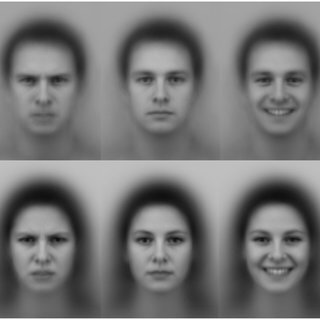
Karolinska Directed Emotional Faces (KDEF) är en uppsättning av totalt 4900 bilder av mänskliga ansiktsuttryck av känslor. Materialet utvecklades 1998 av Daniel Lundqvist, Anders Flykt och professor Arne Öhman vid Karolinska Institutet, Institutionen för klinisk neurovetenskap, Avdelningen för psykologi, Stockholm, Sverige.
Materialet utvecklades ursprungligen för att användas för psykologiska och medicinska forskningsändamål. Mer specifikt utvecklades materialet för att vara särskilt lämpligt för studier av perception, uppmärksamhet, känsla, minne och bakåtmaskning. Därför lades särskilt fokus på att skapa mjuka bilder med jämn ljusstyrka, där uttryck fotograferas från flera vinklar. Därtill används enhetliga T-shirtfärger och ett rutnät för att centrera deltagarnas ansikte under fotografering, och ögon och munnar placeras i fasta bildkoordinater under skanning.
Uppsättningen består av 70 individer som var och en visar 7 olika känslomässiga uttryck, där varje uttryck fotograferas (två gånger) från 5 olika vinklar.
KDEF-stimuli får enbart användas utan kostnad för icke-kommersiella forskningsändamål. All (vidare-)distribution och publicering utan skriftligt medgivande från upphovsrättsinnehavarna är förbjuden. Upphovsrättsinnehavare är Karolinska Institutet, Institutionen för klinisk neurovetenskap, Avdelningen för psykologi, Stockholm, Sverige.
Lundqvist, D., Flykt, A., & Öhman, A. (1998). The Karolinska Directed Emotional Faces – KDEF, CD ROM från Institutionen för klinisk neurovetenskap, psykologsektionen, Karolinska Institutet, ISBN 91-630-7164-9.
KDEF-stimuli består av ett ZIP-arkiv som innehåller de 4900 bilderna och en PDF-fil med allmän information och användningsvillkor.
För att läsa mer och ladda ner KDEF, gå till kdef.se
December, 2023
Together with responsible researcher Lotfi Khemiri, Simon has been granted 170 000 SEK for his project "Oxytocin and prosocial behavior in alcohol use disorder".
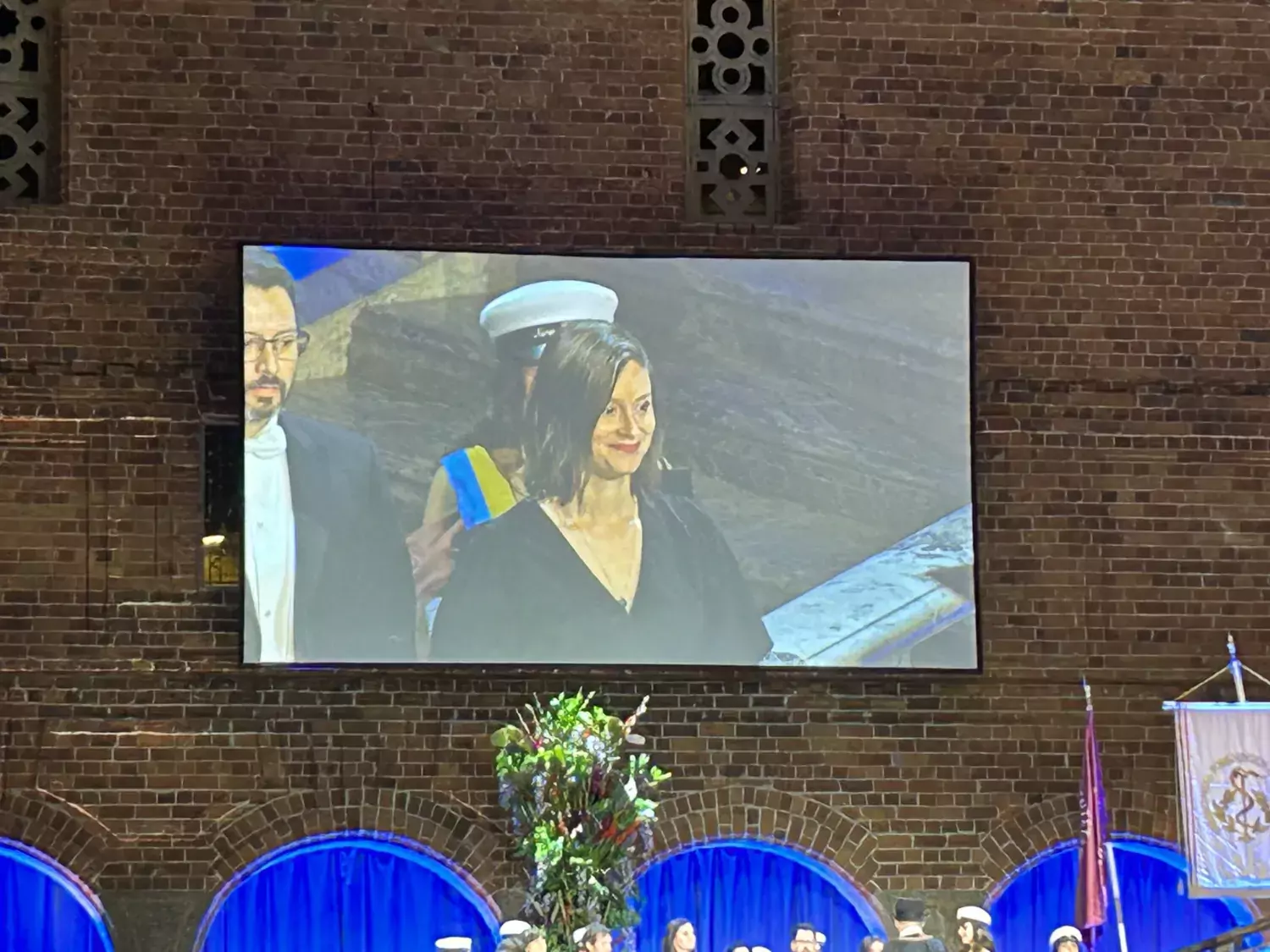
November 10, 2023
Congratulations to Lisa Espinosa who received her accolade in Stockholm City Hall's Blue Hall together with other new KI doctors!
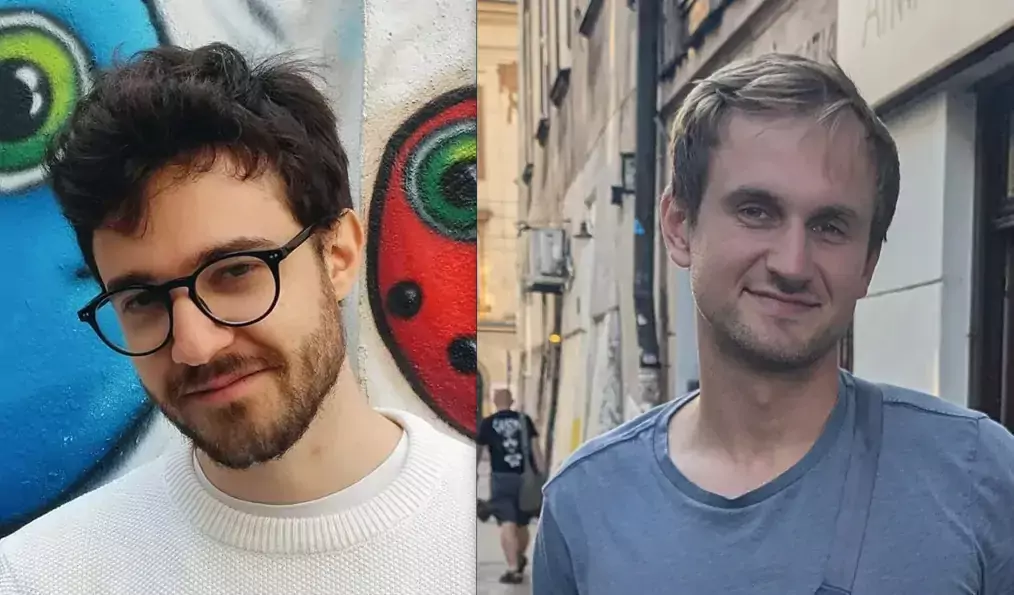
September - October, 2023
We are very happy to welcome two new postdoctoral researchers to our group! Alexandre Bluet received his PhD from the University of Lyon and David Schultner from the University of Amsterdam. They will both work together with Björn Lindström on social learning and cultural transmission.
September 21, 2023
Simon has been awarded this year's Jörgen-Engel scholarship for his article ”Alcohol Use Disorder Displays Trait-Related Reductions in Prosocial Decision Making”. The jury's statement:
Simon Jangard receives the Jörgen Engel scholarship in 2023 for an article in which he investigated a number of different aspects of social decision-making in young people with alcohol use disorder. Through an ambitious study design, he and his colleagues have reached interesting and reliable results, which shed light on a partly new aspect of alcohol problems.
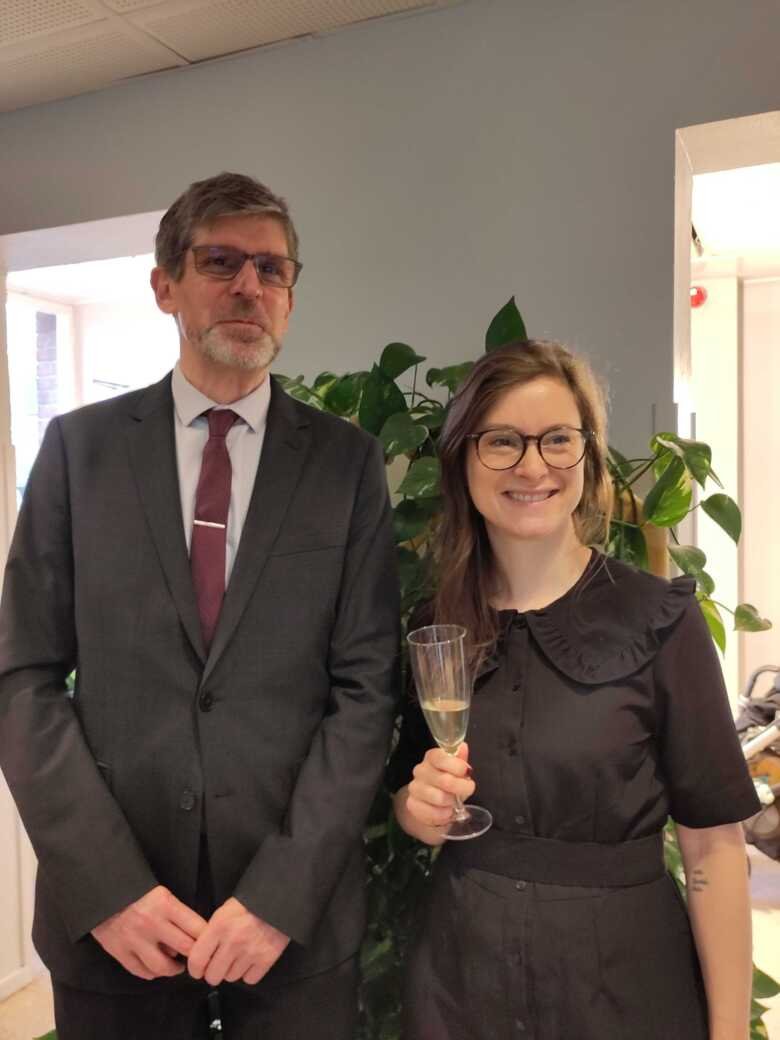
February 16, 2023
Lisa Espinosa successfully defended her doctoral thesis “Social influences on affective responses to negative experiences” at Karolinska Institutet February 16, 2023, with Professor Brian Parkinson, Department of Experimental Psychology, Oxford University, as her opponent.
Examination board: Professor, docent Josefin Sveen, Center for Crisis Psychology, University of Bergen and Department of Women’s and Children’s Health, Uppsala University; Professor Petter Gustavsson, Department of Clinical Neuroscience, Karolinska Institutet; Docent Chris Askew, Department of Medical Sciences, University of Surrey.
November 3, 2022
Acute anxiety during the COVID-19 pandemic was associated with higher levels of everyday altruism.
Vieira JB, Pierzchajlo S, Jangard S, Marsh AA, Olsson A
Sci Rep 2022 Nov;12(1):18619
Oct 25, 2022
Neural defensive circuits underlie helping under threat in humans.
Vieira JB, Olsson A
Elife 2022 Oct;11():
December 14, 2022
Pavlovian threat conditioning can generate intrusive memories that persist over time.
Espinosa L, Bonsall MB, Becker N, Holmes EA, Olsson A
Behav Res Ther 2022 Oct;157():104161

December 9, 2022
Irem Ündeger successfully defended her doctoral thesis “It’s the intention that matters: Neural representations of learning from intentional harm in social interactions” at Karolinska Institutet December 9, 2022 with PhD Joseph Dunsmoor, Department of Psychiatry & Behavioral Sciences, University of Texas, as her opponent.
Examination board: Lecturer senior Erika Jonsson Laukka, Department of Neurobiology, Care Sciences and Society, Karolinska Institutet; Docent Janina Seubert, Department of Clinical Neuroscience, Karolinska Institutet, Karolinska Institutet; Docent Arvid Erlandsson, Department of Behavioural Sciences and Learning, Linköping University.
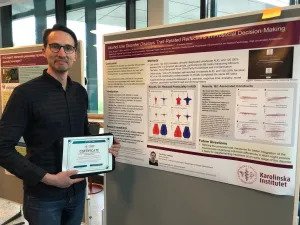
May 18, 2022
Simon received a poster award at the Clinical Neuroscience Department Day, May 16, at Karolinska Institutet, for his poster “Alcohol Use Disorder Displays Trait-Related Reductions on Prosocial Decision-Making”.
May 18, 2022
Alcohol Use Disorder Displays Trait-Related Reductions in Prosocial Decision Making.
Jangard S, Lindström B, Khemiri L, Pärnamets P, Jayaram-Lindström N, Olsson A
Biol Psychiatry Cogn Neurosci Neuroimaging 2022 Sep;7(9):925-934
May 17, 2022
Psychological well-being is associated with prosociality during the COVID-19 pandemic: A comparison of Swedish and Chinese samples.
Pan Y, Vieira JB, Pärnamets P, Jangard S, Cheng X, Zhang Y, Olsson A
Emotion 2022 Aug;():

December 16, 2021
Jonathan successfully defended his doctoral thesis, The impact of social information on emotional learning, on Thursday 16 December, 2021, with Professor Disa Sauter, Faculty of Social and Behavioural Sciences, University of Amsterdam, as his opponent.
Examination board: Dr. India Morrison, Department of Biomedical and Clinical Sciences, Linköping University; Dr. Francisco Esteves, Department of Psychology and Social Work, Mid Sweden University; Dr. Roland Van den Berg, Department of Psychology, Stockholm University.
November 9, 2021
National identity predicts public health support during a global pandemic.
Van Bavel JJ,..., Olsson A,..., Jangard S,..., Pan Y, Papp Z, Pärnamets P,..., Vieira JB, von Sikorski C, Walker AC, Watermeyer J, Wetter E, Whillans A, Willardt R, Wohl MJA, Wójcik AD, Wu K, Yamada Y, Yilmaz O, Yogeeswaran K, Ziemer CT, Zwaan RA, Boggio PS
Nat Commun 2022 Jan;13(1):517
November 9, 2021
Model-based representational similarity analysis of blood-oxygen-level-dependent fMRI captures threat learning in social interactions.
Undeger I, Visser RM, Becker N, de Boer L, Golkar A, Olsson A
R Soc Open Sci 2021 Nov;8(11):202116
September 6, 2021
Observation of others' threat reactions recovers memories previously shaped by firsthand experiences.
Haaker J, Diaz-Mataix L, Guillazo-Blanch G, Stark SA, Kern L, LeDoux JE, Olsson A
Proc Natl Acad Sci U S A 2021 Jul;118(30):
November 27, 2020
Simon has been awarded this year’s Bertil Göransson Scholarship – a 30 000 kr award for alcohol researchers, financed by Systembolaget (Swedish press release).
November 4, 2020
Philip has been awarded 3.2 MSEK to study how decisions and social learning shape intergroup trust.
Trust is fundamental to social behavior and to the functioning of society. Recent work has shown that increasing diversity in society might lead to lower levels of trust. However, how such changes in trust are acquired by individuals and shaped by their experiences is not known. Here we propose to investigate trust as a learning phenomenon, using methods and theories from experimental social psychology and computational reinforcement learning theory. By doing so we address a critical gap in the literature and contribute a behavior-based approach to studying a trust complementing existing survey-based methods. Over the course of three studies we will investigate how participants learn to trust and distrust social partners based on their own and their partners’ ethnic group membership. In the first, we will investigate how decisions about whom to interact with can bias what experiences are available to learn from. In the second, we will investigate the role of observational social learning shaping trust expectations. In the third, we will leverage insights from the first two studies to pilot interventions aimed at increasing trust. The studies will be the first of their kind taking a comprehensive learning approach to trust between members of different ethnic groups and provide critical information how individual experiences shape intergroup trust. These findings can, in turn, not only inform existing theoretical debates but further translational efforts targeting societal trust.
November 1, 2020
Social safety learning: Shared safety abolishes the recovery of learned threat.
Pan Y, Olsson A, Golkar A
Behav Res Ther 2020 Dec;135():103733
September 24, 2020
Enhanced social learning of threat in adults with autism.
Espinosa L, Lundin Kleberg J, Hofvander B, Berggren S, Bölte S, Olsson A
Mol Autism 2020 Sep;11(1):71
September 9, 2020
Integration of social cues and individual experiences during instrumental avoidance learning.
Pärnamets P, Olsson A
PLoS Comput Biol 2020 Sep;16(9):e1008163
August 24, 2020
Help or flight? Increased threat imminence promotes defensive helping in humans.
Vieira JB, Schellhaas S, Enström E, Olsson A
Proc Biol Sci 2020 Aug;287(1933):20201473
April 27, 2020
Neural Pattern Similarity Unveils the Integration of Social Information and Aversive Learning.
Undeger I, Visser RM, Olsson A
Cereb Cortex 2020 Sep;30(10):5410-5419
April 27, 2020
Physiological synchrony predicts observational threat learning in humans.
Pärnamets P, Espinosa L, Olsson A
Proc Biol Sci 2020 May;287(1927):20192779
February 17, 2020
The neural and computational systems of social learning.
Olsson A, Knapska E, Lindström B
Nat Rev Neurosci 2020 Apr;21(4):197-212
January 17, 2020
Learning biases to angry and happy faces during Pavlovian aversive conditioning.
Stussi Y, Pourtois G, Olsson A, Sander D
Emotion 2021 Jun;21(4):742-756
September 2, 2019
Andreas Olsson has been appointed Professor of Psychology at the Department of Clinical Neuroscience at Karolinska Institutet, from 1 September 2019. Congratulations, Andreas!
June 24, 2019
Anxious behaviour in a demonstrator affects observational learning.
Selbing I, Olsson A
Sci Rep 2019 Jun;9(1):9181
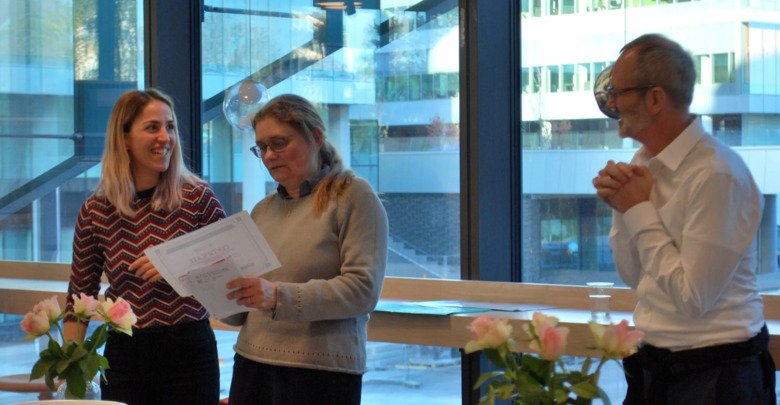
May 15, 2019
Following an afternoon of presentations, the day ended with a poster session. Irem won the best poster award for the Division of Psychology.
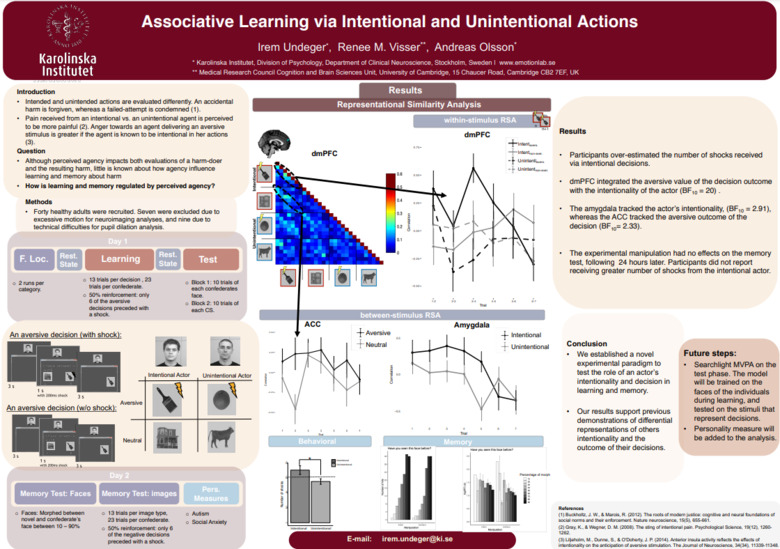
March 24, 2019
Irem has won a Graduate Student Award (GSA) at the Cognitive Neuroscience Society 26th Annual Meeting. You can see her poster here.
January 18, 2019
Social threat learning transfers to decision making in humans.
Lindström B, Golkar A, Jangard S, Tobler PN, Olsson A
Proc Natl Acad Sci U S A 2019 Mar;116(10):4732-4737
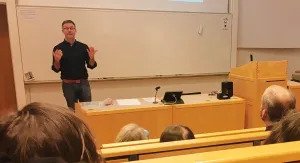
December 7, 2018
Andreas has been awarded the Consolidator Grant (12 M SEK) from the Swedish Research Council for the project “Learning of social values in threatening and safe environments” (2019-2024). The grant will be used to continue our work on how people learn social values, and what cues and conditions leads to fearing or trusting others, both in the lab and in the field.
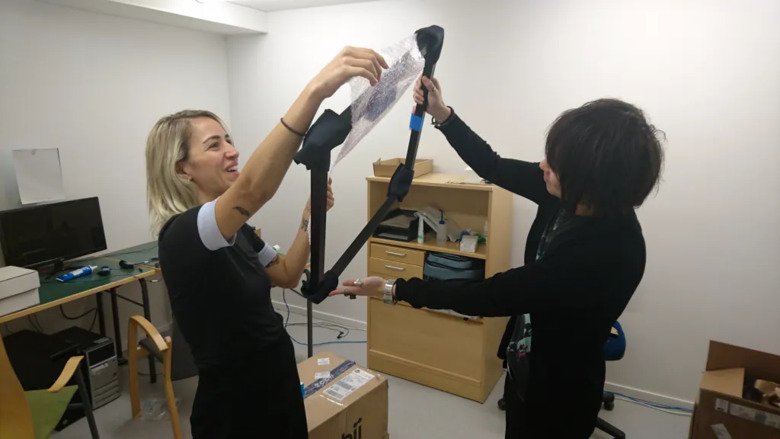
November 15, 2018
We’ve received delivery of our new virtual reality system. Irem and Jonathan will soon begin initial testing in this exciting environment.
October 17, 2018
Social regulation of survival circuits through learning.
Olsson A., FeldmanHall O, Haaker J, Hensler T
Current Opinion in Behavioral Sciences 2018 Dec; 24: 161–167
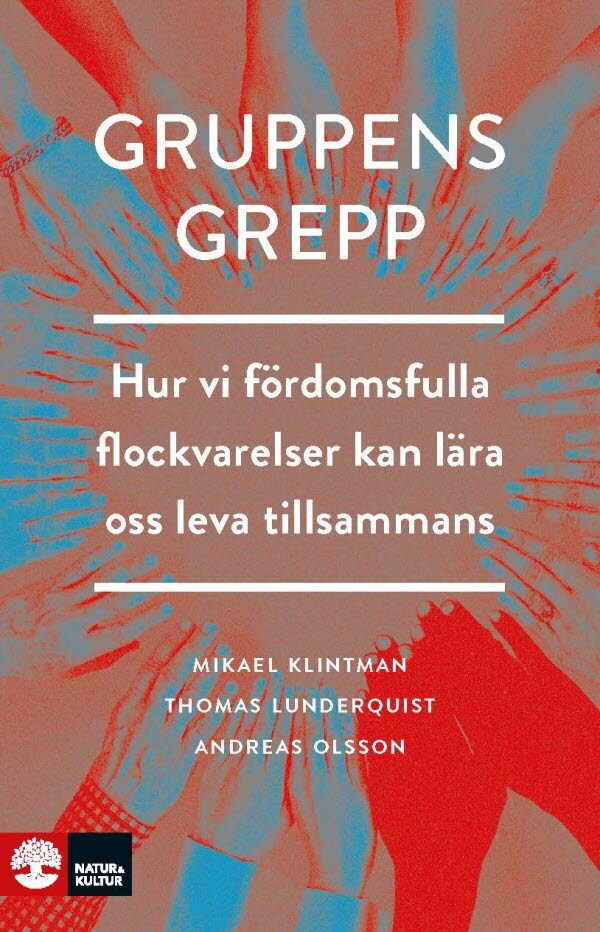
September 27, 2018
This week, Andreas is at the Göteborg Book Fair (Bokmässan) to present his recent book “Gruppens grepp” [Grip of the Group], co-authored with Mikael Klintman and Thomas Lunderquist. It is aimed at those interested in how predjudices are formed, why we have a need to divide the world into “us” and “them” and what throws a spanner in the works of tolerance.
Andreas and Mikael will discuss these topics on Friday 28 September, 12:00-12:20, on Psykologiscenen, C-hallen Monternummer C04:32.
July 25, 2018
Building and Dismantling Trust: From Group Learning to Character Judgments.
Pärnamets P, Granwald T, Olsson A
Proceedings of the 40th Annual Conference of the Cognitive Science Society, Cognitive Science Society, Austin, TX, 2018

June 21, 2018
Fear is a prerequisite for survival. Fear can also prevent us from living. Where does the fear come from? And how are we affected by it? These are some of the questions that psychology researcher Armita Golkar addresses in the third performance of The Royal Dramatic Theatre’s and Nobel Center’s series Performance Lecture. Under the direction of Alexander Mørk-Eidem. Premieres on Lilla scenen on September 11 2018 (the lecture will be given in Swedish).
February 26, 2018
The magazine Medical Science reports on work by Philip and colleagues: Curious about trust: Who do you believe? (Also available in Swedish.)
Who do you trust? Rumours – even when we know they are untrue, affects how much we trust others. And unfortunately, it is easier to destroy trust than to build it. Our capability to trust in others also varies, the researchers are trying to find out more.
December 12, 2017
Swedish public television visited Emotion Lab to report on how people learn from others. The story aired in SVT’s Nobelstudion.

November 21, 2017
A common neural network differentially mediates direct and social fear learning.
Lindström B, Haaker J, Olsson A
Neuroimage 2018 Feb;167():121-129
November 20, 2017
Beliefs about Others' Abilities Alter Learning from Observation.
Selbing I, Olsson A
Sci Rep 2017 Nov;7(1):16173
September 18, 2017
Ida successfully defended her doctoral thesis, Learning from the Behaviors and Experiences of Others, on Monday 18 September (2017) with Professor Christian Ruff (University of Zurich, Department of Economics) as her opponent.
Examination board: Professor Peter Juslin (Uppsala University), Professor Anna Dreber Almenberg (Stockholm School of Economics) and Dr Marc Guitart-Masip (Karolinska Institutet)
August 1, 2017
The role of a "common is moral" heuristic in the stability and change of moral norms.
Lindström B, Jangard S, Selbing I, Olsson A
J Exp Psychol Gen 2018 Feb;147(2):228-242
July 20, 2017
The interplay of social group biases in social threat learning.
Golkar A, Olsson A
Sci Rep 2017 Aug;7(1):7685
June 7, 2017
Social Fear Learning: from Animal Models to Human Function.
Debiec J, Olsson A
Trends Cogn Sci 2017 Jul;21(7):546-555
April 12, 2017
Endogenous opioids regulate social threat learning in humans.
Haaker J, Yi J, Petrovic P, Olsson A
Nat Commun 2017 May;8():15495
February 27, 2017
Philip is part of the 20 most highly rated abstracts that will be presented as posters at this year Social and Affective Neuroscience Society (SANS) conference at UCLA.
January 17, 2017
Neural signals of vicarious extinction learning.
Golkar A, Haaker J, Selbing I, Olsson A
Soc Cogn Affect Neurosci 2016 Oct;11(10):1541-9
December 1, 2016
Philip has received an international postdoctoral grant from the Swedish Research Council (Vetenskaprsådet) for three years. He will join Jay Van Bavel’s Social Perception and Evaluation Lab at New York University for 2 years and spend his returning year with Emotion Lab.
December 1, 2016
Vetenskapssocieteten i Lund (Learned Society of Lund) has awarded Philip with a prize from AWK Gleerups fund for his 2015 dissertation “Observing and manipulating preferences in real time”.
October 11, 2016
Neural signals of vicarious extinction learning.
Golkar A, Haaker J, Selbing I, Olsson A
Soc Cogn Affect Neurosci 2016 Oct;11(10):1541-9
October 21, 2016
Tanaz successfully defended her doctoral thesis, The role of aversive learning in social interactions, on Friday October 21st (2016 with Dr. Grit Hein (University of Bern) as her opponent.
Examination board: Prof. Håkan Fischer (Stockholm University), Dr. Fredrik Åhs (Uppsala University) and Dr. Lisa Thorell (Karolinska Institutet).
October 20, 2016
To fear or not to fear? Mechanisms of fear and safety learning.
Guest speakers: Armita Golkar, Emily Holmes (Karolinska Institutet), Merel Kindt (U. of Amsterdam), and Grit Hein (U. of Bern)
October 1, 2016
Conditioned social dominance threat: observation of others' social dominance biases threat learning.
Haaker J, Molapour T, Olsson A
Soc Cogn Affect Neurosci 2016 Oct;11(10):1627-37
July 27, 2016
Co-Evolution of Social Learning and Evolutionary Preparedness in Dangerous Environments.
Lindström B, Selbing I, Olsson A
PLoS One 2016 ;11(8):e0160245
June 14, 2016
Aversive Learning and Trait Aggression Influence Retaliatory Behavior.
Molapour T, Lindström B, Olsson A
Front Psychol 2016 ;7():833
April 26, 2016
Philip receives the 2016 Robert J. Glushko Dissertation Prize awarded by the Cognitive Science Society and the Glushko-Samuelson Foundation.
April 26, 2016
Irem receives the first price in the Poster competition at the Eighth European Meeting on Humain Fear Conditioning in Utrecht (2016).
Undeger, I. & Olsson, A. (2016). Effects of agency on learning fear from others. European Meeting of Humain Fear Conditioning, Utrecht, April 2016.
March 22, 2016
Immunization against social fear learning.
Golkar A, Olsson A
J Exp Psychol Gen 2016 Jun;145(6):665-71
January 11, 2016
Björn discusses our research on BBC Radio 4.
Listen to it here, or read the article linked below.
Mechanisms of social avoidance learning can explain the emergence of adaptive and arbitrary behavioral traditions in humans.
Lindström B, Olsson A
J Exp Psychol Gen 2015 Jun;144(3):688-703
November 19, 2015
The Swedish National Committee for Psychological Sciences at the Royal Swedish Academy of Sciences, granted Armita Golkar the award for outstanding young researcher in Psychology.
July 9, 2015
Vicarious Fear Learning Depends on Empathic Appraisals and Trait Empathy.
Olsson A, McMahon K, Papenberg G, Zaki J, Bolger N, Ochsner KN
Psychol Sci 2016 Jan;27(1):25-33
July 7, 2015
Neural correlates of biased social fear learning and interaction in an intergroup context.
Molapour T, Golkar A, Navarrete CD, Haaker J, Olsson A
Neuroimage 2015 Nov;121():171-83
February 26, 2015
Mechanisms of social avoidance learning can explain the emergence of adaptive and arbitrary behavioral traditions in humans.
Lindström B, Olsson A
J Exp Psychol Gen 2015 Jun;144(3):688-703
February 9, 2015
Testosterone and estrogen impact social evaluations and vicarious emotions: A double-blind placebo-controlled study.
Olsson A, Kopsida E, Sorjonen K, Savic I
Emotion 2016 Jun;16(4):515-23
January 21, 2015
December 11, 2014
Social learning of fear and safety is determined by the demonstrator's racial group.
Golkar A, Castro V, Olsson A
Biol Lett 2015 Jan;11(1):20140817
December 10, 2014
A ten-year follow-up of a study of memory for the attack of September 11, 2001: Flashbulb memories and memories for flashbulb events.
Hirst W, Phelps EA, Meksin R, Vaidya CJ, Johnson MK, Mitchell KJ, Buckner RL, Budson AE, Gabrieli JD, Lustig C, Mather M, Ochsner KN, Schacter D, Simons JS, Lyle KB, Cuc AF, Olsson A
J Exp Psychol Gen 2015 Jun;144(3):604-23
December 3, 2014
Björn Lindström received post-doc funding from the Swedish Research Council (Vetenskapsrådet).
Teamet Mechanisms of Social Behavior undersöker de psykologiska, beräkningsmässiga och neurala grunderna för socialt lärande och kulturell evolution. Vår forskning integrerar beräkningsmodellering och simuleringar av flera agenter med beteende- och neuroavbildningsexperiment, efter en rigorös, teoridriven strategi.